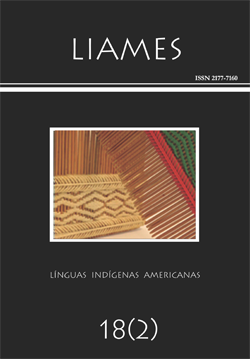Resumo
This paper offers the first characterization of the ethnobiological taxonomic system used by the Kakataibo people (Pano, Peru) to classify and organize their knowledge about nature. The study follows the six ranks proposed for folk taxonomies (see Berlin et al 197; Berlin 1992), but the data suggest that the Kakataibo taxonomic system exhibits an extra taxonomic level in association with culturally and perceptually more salient categories, producing highly complex classifications (non-salient categories exhibit much simpler internal organizations). This paper also demonstrates the existence of overlapping plant classifications, which seem to be relevant for the understanding of the whole Kakataibo taxonomic system.
Referências
Anderson, E.N. (2000). Maya knowledge and “science wars”. Journal of Etnobiology 20: 129-158.
Anderson, E.N. (2011). Ethnobiology: Overview of a growing field. In E.N. Anderson; D. Pearsall; Eugene Hunn; N. Turner (eds.). Ethnobiology: 1-14. New Jersey: Wiley-Blackwell. https://doi.org/10.1002/9781118015872.ch1
Berlin, Brent (1973). Folk systematics in relation to biological classification and nomenclature. Annual Review of Ecology and Systematics, vol. 4: 259-271.
Berlin, Brent (1974). Further notes on covert categories and folk taxonomies: A reply to Brown. American Anthropologist, New Series, vol. 76(2): 327-331.
Berlin, Brent (1976). The concept of rank in ethnobiological classification: Some evidence from Aguaruna folk botany. American Ethnologist, vol. 3(3) (Folk Biology): 381-399.
Berlin, Brent (1992). Ethnobiological classification: principles of categorization of plants and animals in traditional societies. Princeton: Princeton University Press.
Berlin, Brent; Denisse Breedlove & Peter Raven (1973). General principles of classification and nomenclature in folk biology. American Anthropology 75(1): 214-242.
Dienst, Stefan; David W. Fleck (2009). Pet vocatives in south-western Amazonia. Anthropological Linguistics 51: 209-243.
Fleck, David W. (2007). Field linguistics meets biology: how to obtain scientific designations for plant and animal names. Language Typology and Universals, vol. 60(1): 81-91. doi: https://doi.org/10.1524/stuf.2007.60.1.3
Fleck, David W. (2013). Pano languages and linguistics. Anthropological Papers of the American Museum of Natural History 99. Available at:
http://biblio.wdfiles.com/local--files/fleck-2013-pano/fleck_2013_pano.pdf
Fleck, David W.; Harder, John D. (2000). Matses Indian rainforest habitat classification and mammalian diversity in Amazonian Peru. Journal of Ethnobiology 20(1): 1-36. Available at: https://ethnobiology.org/sites/default/files/pdfs/JoE/20-1/FleckHarder.pdf
Fleck, David.W.; Voss, Robert S. (2006). On the origin and cultural significance of unusually large synonym sets in some Pano languages of western Amazonia. Anthropological Linguistics 48(4): 335-368.
Fleck, David W.; Voss Robert S.; Simmons, N.B. (2002). Underdifferentiation and sublexemic categories: An example from Matses bat classification. Journal of Ethnobiology 22(1): 63-104.
Gilmore, Michael P.; Eshbaugh, W. Hardy (2011). From researcher to partner: ethical challenges and issues facing the ethnobiological researcher. In Anderson, E.N.; D. Pearsall, Eugene. Hunn; N. Turner (eds.). Ethnobiology, pp. 51-64. New Jersey: Wiley-Blackwell. doi: https://doi.org/10.1002/9781118015872.ch4
González, Roberto J. (2001). Zapotec science: farming and food in the Northern Sierra of Oaxaca. Austin: University of Texas Press.
Hardison, P.; Bannister, K. (2011). Ethics in ethnobiology: history, international law and policy, and contemporary issues. In Anderson, E.N.; D. Pearsall; Eugene. Hunn; N. Turner (eds.). Ethnobiology, pp. 27-50. New Jersey: Wiley-Blackwell.
Hunn, Eugene S. (1976). Toward a perceptual model of folk biological classification. American Ethnobiology 3(3): 508-524.
Hunn, Eugene S.; Brown Cecil H. (2011). Linguistic Ethnobiology. In Anderson, E.N.; D. Pearsall; Turner N. (eds.). Ethnobiology, pp.319-333. New Jersey: Wiley-Blackwell. doi: https://doi.org/10.1002/9781118015872.ch19
Instituto Nacional de Estadística e Informática (INEI) (2007). II Censo de Comunidades Indígenas de la Amazonia. http://iinei.inei.gob.pe/iinei/RedatamCpv2007.asp?ori=C (revised in May 2009).
Lévi-Strauss, Claude (1966). The savage mind. London: Weidenfeld and Nicolson.
Shell, Olive (1987). Vocabulario cashibo-cacataibo. Yarinacocha, Pucallpa: Ministerio de Educación e Instituto Lingüístico de Verano. Available at:
http://www.peru.sil.org/resources/archives/29813
Simpson, George G. (1961). Principles of animal taxonomy. New York: Columbia University Press.
Tessmann, Günter (1930). Die Indianer Nordost-Perus: Grundlegende Forschungen für eine systematische Kulturkunde. Hamburg: Friederichsen, de Gruyter & Co. m.b.H. (Spanish translation: 1999. Los indios del Perú Nororiental. Translated by Gunda Wierhake. Quito, Ecuador: Abyayala.)
Tournon, Jacques (1991). La clasificación de los vegetales entre los shipibo-conibo. Antropológica 9(9): 119-151.
Tournon, Jacques (1994). Como los Shipibo-Conibo nombran y clasifican los animales Anthropológica 11(11): 91-108.
Tournon, Jacques; Caúper Samuel P. (1994). Los shipibo-conibo y la fauna acuática. Anthropológica 12(12): 27-61.
Valenzuela, Pilar (1998). “Luna-Avispa” y “Tigre-Machaco”: Compuestos semánticos en la taxonomía Shipiba. In Zarina Estrada; Max Figueroa; Gerardo López; Andrés Costa (eds.). IV. Encuentro Internacional de Lingüística del Noroeste. Memorias, t. 1, vol. 2: 409-428.
Valenzuela, Pilar (2000). Major categories in Shipibo ethnobiological taxonomy. Anthropological Linguistics 42(1): 1-36.
Voss, Robert S.; Fleck David W. (2011). Mammalian diversity and Matses ethnomammalogy in Amazonian Peru. Part 1: Primates. Bulletin of the American Museum of Natural History 351. URL: http://hdl.handle.net/2246/6111
Wistrand de Robinson, Lila (1984). Biota of the Cashibo/Cacataibo of Peru, giving (where identifiable) scientific name, Cashibo, Spanish, and English I-II. Forest, VA: Lingua Folks Publications.
Zariquiey, Roberto (2011a). A grammar of Kakataibo (Ph.D. dissertation). Melbourne, Australia: La Trobe University.
Zariquiey, Roberto (2011b). Hacia una dialectología del idioma Kakataibo. Lexis 35(1): 5-46.
Zariquiey, Roberto (2014). Name types, polysemy and contrast sets in Kakataibo. Ethnobiological Nomenclature (Pano, Peru). Journal of Ethnobiology 34 (2): 251-272. https://doi.org/10.2993/0278-0771-34.2.251
Zariquiey, Roberto; Fleck, David W. Estrella, Alfredo; Estrella, Emilio; Estrella, Salomón; Odicio, Ricardo; Pereira, Ricardo (2017). Plantas y animales del pueblo Kakataibo. Diccionario Etnobiológico. Lima: Ministerio de Educación del Perú.
Zariquiey, Roberto; Odicio, Wilton (eds.) (2017). Relatos orales Kakataibo. Nun baban nun bëchikën ‘unanti kakataibonën bana. Historias y cuentos kakataibo para que aprendan nuestros hijos y nuestros nietos. Lima: Ministerio de Educación del Perú.
A LIAMES: Línguas Indígenas Americanas utiliza a licença do Creative Commons (CC), preservando assim, a integridade dos artigos em ambiente de acesso aberto.
Os artigos e demais trabalhos publicados na LIAMES: Línguas Indígenas Americanas, publicação de acesso aberto, passa a seguir os princípios da licença do Creative Commons. Uma nova publicação do mesmo texto, de iniciativa de seu autor ou de terceiros, fica sujeita à expressa menção da precedência de sua publicação neste periódico, citando-se a edição e a data desta publicação.


